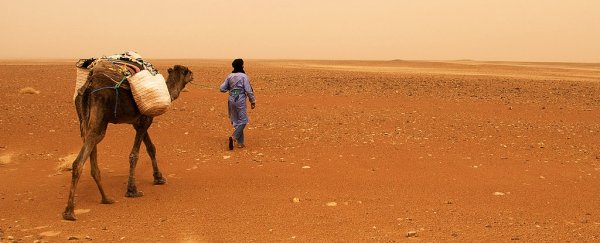Before the Sahara became the arid and inhospitable desert it is today, humans thrived there - even cultivating and storing wild grains, according to new research. This discovery marks the earliest evidence of the farming of cereal seeds in Africa.
Some 10,000 years ago, during the early Holocene, the Sahara desert looked very different. Up until around 5,000 years ago, the region was thought to be lush and fertile, covered with vegetation and lakes. This was known as the African Humid Period.
During this time, a place now known as the Takarkori rock shelter was frequented by human hunter-gatherers. Sediments and fibre artefacts such as baskets and rock art point to a long history of a human presence.
It was in this region that researchers from the University of Huddersfield and the University of Modena & Reggio Emilia found over 200,000 cereal seeds in small, circular concentrations, indicating that those Takarkori hunter-gatherers practiced an early form of agriculture - cultivating and storing crops.
Moreover, these were wild plants, more akin to plants that we would today consider weeds than domesticated crops. These plants flourish in human environments due to their preference for disturbed soils, and they're highly adaptable and aggressive, making them effective invaders in agricultural (and garden) settings.
These traits, according to the researchers, would have been much more desirable to the hunter-gatherers, at least partially because they could adapt to survive in changing environmental conditions.
"We present the first evidence that non-agricultural societies selected plants for traits that overlap a considerable degree with traits that are characteristic of plants now considered as weeds," the researchers wrote in their paper.
After enlisting an entomologist to determine that industrious insects hadn't created the seed caches, the researchers delved into the seeds themselves.
 (Mercuri et al., Nature Plants, 2018)
(Mercuri et al., Nature Plants, 2018)
They uncovered 30 seed deposits at the site, consisting mainly of wild cereals, a strong indication that the seeds were used for food. The seeds mainly consisted of various kinds of grass, and showed evidence of threshing and winnowing, as well as being used for feeding and bedding animals.
The seeds were mostly of a kind that have strong seed dormancy - that is, they don't germinate until the following season - making them suitable for storage purposes. This is in direct contrast to domesticated crops, many of which have greatly reduced seed dormancy.
Some of the seeds showed morphological differences to the more usual seed shapes. This, the researchers suggest, shows that the plants were being cultivated, the changes forced by human selection without causing domestication, as has been seen in China and Syria.
As well as being fascinating and filling in some of Africa's rich history, the research could help humanity's future survival efforts. Weedy traits in edible plants could prove to be indispensable in a world that seems to be irrevocably changing.
"The same behaviour that allowed these plants to survive in a changing environment in a remote past makes them some of the most likely possible candidates as staple resources in a coming future of global warming," the researchers wrote in their paper.
"Our research suggests that, similarly to modern gatherers, we should pay renewed attention to these plants in the hope of finding innovative responses to tackle desertification and biodiversity loss."
The paper has been published in the journal Nature Plants.
